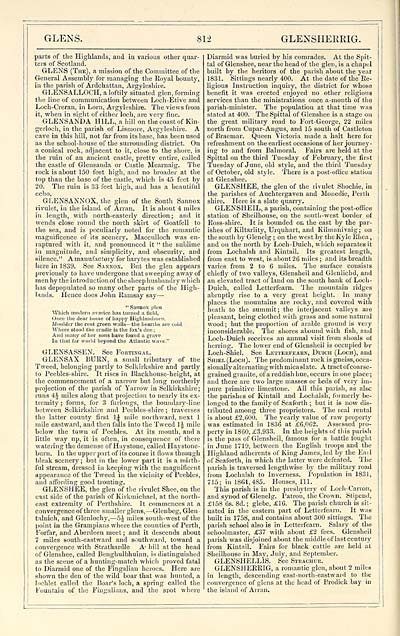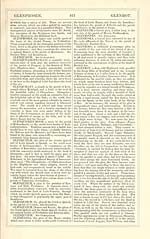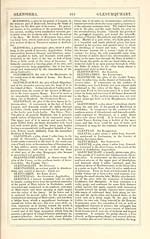Download files
Complete book:
Individual page:
Thumbnail gallery: Grid view | List view

GLENS.
812
GLENSHERRIG.
parts of the Highlands, and in various other quar-
ters of Scotland.
GLENS (The), a mission of the Committee of the
General Assembly for managing the Royal bounty,
in the parish of Ardchattan, Argyleshire.
GLENSALLOCH, a loftily situated glen, forming
the line of communication between Loch-Etive and
Loch-Creran, in Lorn, Argyleshire. The views from
it, when in sight of either loch, are very fine.
GLENSANDA HILL, a hill on the coast of Kin-
gerloch, in the parish of Lismore, Argyleshire. A
cave in this hill, not far from its base, has been used
as the school-house of the surrounding district. On
a conical rock, adjacent to it, close to the shore, is
the ruin of an ancient castle, pretty entire, called
the castle of Glensanda or Castle Mearnaig. The
rock is about 150 feet high, and no broader at the
top than the base of the castle, which is 45 feet by
20. The ruin is 33 feet high, and has a beautiful
echo.
GLENSANNOX, the glen of the South Sannox
rivulet, in the island of Arran. It is about 4 miles
in length, with north-easterly direction ; and it
wends close round the north skirt of Goatfell to
the sea, and is peculiarly noted for the romantic
magnificence of its scenery. Macculloch was en-
raptured with it, and pronounced it " the sublime
in magnitude, and simplicity, and obscurity, and
silence." A manufactory for bary tes was established
here in 1839. See Sannox. But the glen appears
previously to have undergone that sweeping away of
men by the introduction of the sheep husbandry which
has depopulated so many other parts of the High-
lands. Hence does John Ramsay sa) r —
"Sannox plell
Which modern avarice has turned a field.
Once the deal- home of happy Highlandineti.
Moulder the rent green walls— the hearths are cold.
Where stood the cradle is the fox's den;
And many of her sons have found a grave
In that far world heyond the Atlantic wave."
GLENSASSEX. See Fortingal.
GLENSAX BURN, a small tributary of the
Tweed, belonging partly to Selkirkshire and partly
to Peebles-shire. It rises in Blackhouse-height, at
the commencement of a narrow but long northerly
projection of the parish of Yarrow in Selkirkshire;
runs 4£ miles along that projection to nearly its ex-
tremity ; forms, for 3 furlongs, the boundary-line
between Selkirkshire and Peebles-shire ; traverses
the latter county first li mile northward, next 1
mile eastward, and then falls into the Tweed 1 J mile
below the town of Peebles. At its mouth, and a
little way up, it is often, in consequence of there
watering the demense of Haystone, called Haystone-
burn. In the upper part of its course it flows through
hleak scenery; but in the lower part it is a mirth-
ful stream, dressed in keeping with the magnificent
appearance of the Tweed in the vicinity of Peebles,
and affording good trouting.
GLENSHEE, the glen of the rivulet Shee, on the
east side of the parish of Kirkmichael, at the north-
east extremity of Perthshire. It commences at a
convergence of three smaller glens, — Glenbeg, Glen-
talnich, and Glenlochy, — 5h miles south-west of the
point in the Grampians where the counties of Perth,
Forfar, and Aberdeen meet ; and it descends about
7 miles south-eastward and southward, toward a
convergence with Strathardle A- hill at the head
of Glenshee, called Benghulbhuinn, is distinguished
as the scene of a hunting-match which proved fatal
to Diarmid one of the Fingalian heroes. Here are
shown the den of the wild boar that was hunted, a
lochlet called the Hoar's loch, a spring called the
fountain of the Fingalians, and the spot where
Diarmid was buried by his comrades. At the Spit-
tal of Glenshee, near the head of the glen, is a chapel
built by the heritors of the parish about the year
1831. Sittings nearly 400. At the date of the Re-
ligious Instruction inquiry, the district for whose
benefit it was erected enjoyed no other religious
services than the ministrations once a-month of the
parish-minister. The population at that time was
stated at 400. The Spittal of Glenshee is a stage on
the great military road to Fort-George, 22 miles
north from Cupar-Angus, and 15 south of Castleton
of Braemar. Queen Victoria made a halt here for
refreshment on the earliest occasions of her journey-
ing to and from Balmoral. Fairs are held at the
Spittal on the third Tuesday of February, the first
Tuesda}' of June, old style, and the third Tuesday
of October, old style. There is a post-office station
at Glenshee.
GLENSHEE, the glen of the rivulet Shochie, in
the parishes of Auchtergaven and Monedie, Perth
shire. Here is a slate quarry.
GLENSHEIL, a parish, containing the post-office
station of Sheilhouse, on the south-west border o{
Ross-shire. It is bounded on the east by the par-
ishes of Kiltarlity, Urquhart, and Kilmanivaig ; on
the south by Glenelg ; on the west by the Kyle Rhea ,
and on the north by Loch-Duich, which separates it
from Lochalsh and Kintail. Its greatest length,
from east to west, is about 26 miles ; and its breadth
varies from 2 to G miles. The surface consists
chiefly of two valleys, Glensheil and Glenlichd, and
an elevated tract of land on the south bank of Loch-
Duich, called Letterfearn. The mountain ridges
abruptly rise to a very great height. In many
places the mountains are rocky, and covered with
heath to the summit; the interjacent valleys are
pleasant, being clothed with grass and some natural
wood; but the proportion of arable ground is very
inconsiderable. The shores abound with fish, and
Loch-Duich receives an annual visit from shoals oi
herring. The lower end of Glensheil is occupied bv
Loch-Shiel. See Letterfearn, Duich (Loch), and
Shiel (Loch). The predominant rock is gneiss, occa-
sionally alternating with mica slate. A tract of coarse-
grained granite, of a reddish hue, occurs in one place;
and there are two large masses or beds of very im-
pure primitive limestone. All this parish, as alsc
the parishes of Kintail and Lochalsh, formerly be-
longed to the family of Seaforth ; but it is now dis-
tributed among three proprietors. The real rental
is about £2,000. The yearly value of raw property
was estimated in 1830 at £6,002. Assessed pro-
perty in 1860, £3,933. In the heights of this parish
is the pass of Glensheil, famous for a battle fought
in June 1719, between the English troops and the
Highland adherents of King James, led by the Fai 1
of Seaforth, in which the latter were defeated. The
parish is traversed lengthwise by the military road
from Lochalsh to Inverness. Population in 1831,
715; in 1801,485. Houses, HI.
This parish is in the presbytery of Loch-Carron,
and synod of Glenelg. Patron, the Crown. Stipend,
£158 6s. 8d. ; glebe, £16. The parish church is sit-
uated in the eastern part of Letterfearn. It was
built in 1758, and contains about 300 sittings. The
parish school also is in Letterfearn. Salary of the
schoolmaster, £37 with about £2 fees. Glensheil
parish was disjoined about the middle of last century
from Kintail. Fairs for black cattle are held at
Sheilhouse in May, July, and September.
GLENSHELLiS. See Strachur.
GLENSHERRIG, a romantic glen, about 2 miles
in length, descending east-north-eastward to the
convergence of glens at the head of Brodick bay in
the island of Arran.
812
GLENSHERRIG.
parts of the Highlands, and in various other quar-
ters of Scotland.
GLENS (The), a mission of the Committee of the
General Assembly for managing the Royal bounty,
in the parish of Ardchattan, Argyleshire.
GLENSALLOCH, a loftily situated glen, forming
the line of communication between Loch-Etive and
Loch-Creran, in Lorn, Argyleshire. The views from
it, when in sight of either loch, are very fine.
GLENSANDA HILL, a hill on the coast of Kin-
gerloch, in the parish of Lismore, Argyleshire. A
cave in this hill, not far from its base, has been used
as the school-house of the surrounding district. On
a conical rock, adjacent to it, close to the shore, is
the ruin of an ancient castle, pretty entire, called
the castle of Glensanda or Castle Mearnaig. The
rock is about 150 feet high, and no broader at the
top than the base of the castle, which is 45 feet by
20. The ruin is 33 feet high, and has a beautiful
echo.
GLENSANNOX, the glen of the South Sannox
rivulet, in the island of Arran. It is about 4 miles
in length, with north-easterly direction ; and it
wends close round the north skirt of Goatfell to
the sea, and is peculiarly noted for the romantic
magnificence of its scenery. Macculloch was en-
raptured with it, and pronounced it " the sublime
in magnitude, and simplicity, and obscurity, and
silence." A manufactory for bary tes was established
here in 1839. See Sannox. But the glen appears
previously to have undergone that sweeping away of
men by the introduction of the sheep husbandry which
has depopulated so many other parts of the High-
lands. Hence does John Ramsay sa) r —
"Sannox plell
Which modern avarice has turned a field.
Once the deal- home of happy Highlandineti.
Moulder the rent green walls— the hearths are cold.
Where stood the cradle is the fox's den;
And many of her sons have found a grave
In that far world heyond the Atlantic wave."
GLENSASSEX. See Fortingal.
GLENSAX BURN, a small tributary of the
Tweed, belonging partly to Selkirkshire and partly
to Peebles-shire. It rises in Blackhouse-height, at
the commencement of a narrow but long northerly
projection of the parish of Yarrow in Selkirkshire;
runs 4£ miles along that projection to nearly its ex-
tremity ; forms, for 3 furlongs, the boundary-line
between Selkirkshire and Peebles-shire ; traverses
the latter county first li mile northward, next 1
mile eastward, and then falls into the Tweed 1 J mile
below the town of Peebles. At its mouth, and a
little way up, it is often, in consequence of there
watering the demense of Haystone, called Haystone-
burn. In the upper part of its course it flows through
hleak scenery; but in the lower part it is a mirth-
ful stream, dressed in keeping with the magnificent
appearance of the Tweed in the vicinity of Peebles,
and affording good trouting.
GLENSHEE, the glen of the rivulet Shee, on the
east side of the parish of Kirkmichael, at the north-
east extremity of Perthshire. It commences at a
convergence of three smaller glens, — Glenbeg, Glen-
talnich, and Glenlochy, — 5h miles south-west of the
point in the Grampians where the counties of Perth,
Forfar, and Aberdeen meet ; and it descends about
7 miles south-eastward and southward, toward a
convergence with Strathardle A- hill at the head
of Glenshee, called Benghulbhuinn, is distinguished
as the scene of a hunting-match which proved fatal
to Diarmid one of the Fingalian heroes. Here are
shown the den of the wild boar that was hunted, a
lochlet called the Hoar's loch, a spring called the
fountain of the Fingalians, and the spot where
Diarmid was buried by his comrades. At the Spit-
tal of Glenshee, near the head of the glen, is a chapel
built by the heritors of the parish about the year
1831. Sittings nearly 400. At the date of the Re-
ligious Instruction inquiry, the district for whose
benefit it was erected enjoyed no other religious
services than the ministrations once a-month of the
parish-minister. The population at that time was
stated at 400. The Spittal of Glenshee is a stage on
the great military road to Fort-George, 22 miles
north from Cupar-Angus, and 15 south of Castleton
of Braemar. Queen Victoria made a halt here for
refreshment on the earliest occasions of her journey-
ing to and from Balmoral. Fairs are held at the
Spittal on the third Tuesday of February, the first
Tuesda}' of June, old style, and the third Tuesday
of October, old style. There is a post-office station
at Glenshee.
GLENSHEE, the glen of the rivulet Shochie, in
the parishes of Auchtergaven and Monedie, Perth
shire. Here is a slate quarry.
GLENSHEIL, a parish, containing the post-office
station of Sheilhouse, on the south-west border o{
Ross-shire. It is bounded on the east by the par-
ishes of Kiltarlity, Urquhart, and Kilmanivaig ; on
the south by Glenelg ; on the west by the Kyle Rhea ,
and on the north by Loch-Duich, which separates it
from Lochalsh and Kintail. Its greatest length,
from east to west, is about 26 miles ; and its breadth
varies from 2 to G miles. The surface consists
chiefly of two valleys, Glensheil and Glenlichd, and
an elevated tract of land on the south bank of Loch-
Duich, called Letterfearn. The mountain ridges
abruptly rise to a very great height. In many
places the mountains are rocky, and covered with
heath to the summit; the interjacent valleys are
pleasant, being clothed with grass and some natural
wood; but the proportion of arable ground is very
inconsiderable. The shores abound with fish, and
Loch-Duich receives an annual visit from shoals oi
herring. The lower end of Glensheil is occupied bv
Loch-Shiel. See Letterfearn, Duich (Loch), and
Shiel (Loch). The predominant rock is gneiss, occa-
sionally alternating with mica slate. A tract of coarse-
grained granite, of a reddish hue, occurs in one place;
and there are two large masses or beds of very im-
pure primitive limestone. All this parish, as alsc
the parishes of Kintail and Lochalsh, formerly be-
longed to the family of Seaforth ; but it is now dis-
tributed among three proprietors. The real rental
is about £2,000. The yearly value of raw property
was estimated in 1830 at £6,002. Assessed pro-
perty in 1860, £3,933. In the heights of this parish
is the pass of Glensheil, famous for a battle fought
in June 1719, between the English troops and the
Highland adherents of King James, led by the Fai 1
of Seaforth, in which the latter were defeated. The
parish is traversed lengthwise by the military road
from Lochalsh to Inverness. Population in 1831,
715; in 1801,485. Houses, HI.
This parish is in the presbytery of Loch-Carron,
and synod of Glenelg. Patron, the Crown. Stipend,
£158 6s. 8d. ; glebe, £16. The parish church is sit-
uated in the eastern part of Letterfearn. It was
built in 1758, and contains about 300 sittings. The
parish school also is in Letterfearn. Salary of the
schoolmaster, £37 with about £2 fees. Glensheil
parish was disjoined about the middle of last century
from Kintail. Fairs for black cattle are held at
Sheilhouse in May, July, and September.
GLENSHELLiS. See Strachur.
GLENSHERRIG, a romantic glen, about 2 miles
in length, descending east-north-eastward to the
convergence of glens at the head of Brodick bay in
the island of Arran.
Set display mode to: Large image | Transcription
Images and transcriptions on this page, including medium image downloads, may be used under the Creative Commons Attribution 4.0 International Licence unless otherwise stated. ![]()
| Gazetteers of Scotland, 1803-1901 > Imperial gazeteer of Scotland, or, Dictionary of Scottish topography > Volume 1 > (952) Page 812 |
|---|
| Permanent URL | https://digital.nls.uk/97470554 |
|---|
| Description | Volume I: Aan-Gordon. |
|---|---|
| Attribution and copyright: |
|

